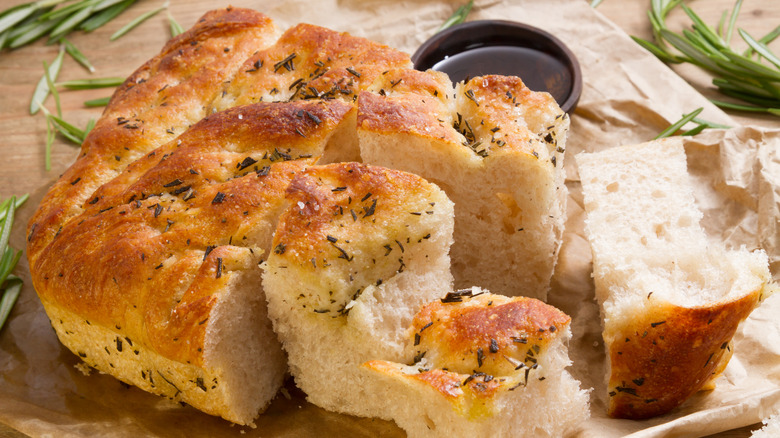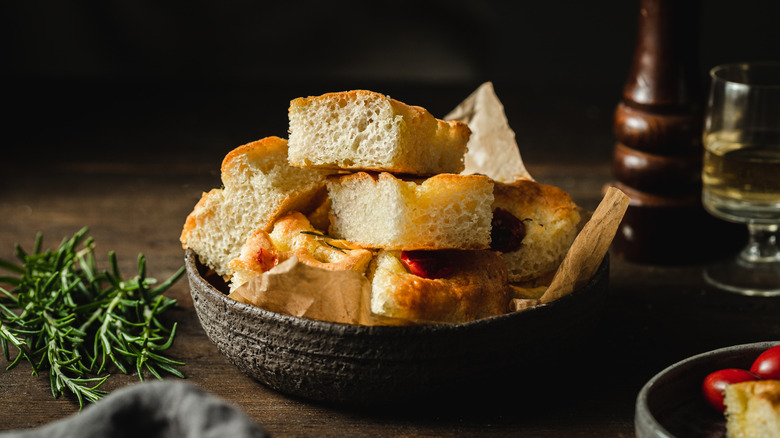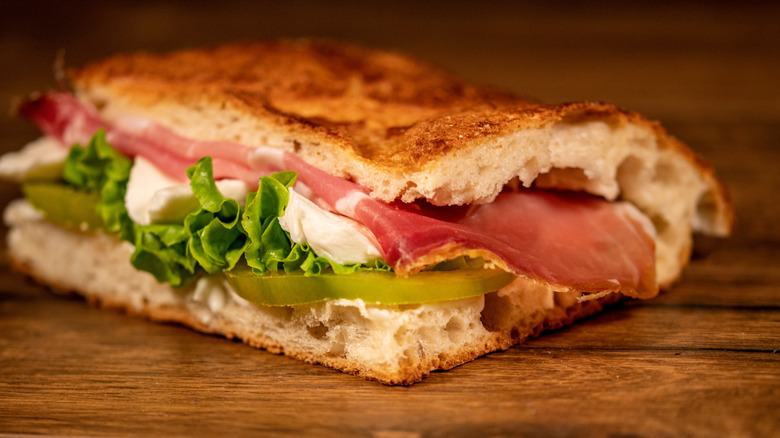How To Pick Out Great Store-Bought Focaccia Bread
If you're lucky enough to live near an Italian bakery, it may be easy to source authentic focaccia bread, saving you the time of making the dough and waiting it to rise if you make it yourself. However, if you only have a generic grocery store to shop at, it may be more challenging to source a high-quality version of this fluffy flatbread. When you take a closer look at a loaf of focaccia, there are a few cues that can signal you've found a quality product.
Firstly, if you've had well-made focaccia at your favorite Italian spot, you already know that it's a little different from other flatbreads like pitas, naan, or even pizza. It's not very thin, instead ranging in height from a half to a full inch. You'll want to scope out a loaf that falls into that range. Since many grocers sell bread in packages that are at least partially transparent, it should be easy to see if the focaccia has just the right thickness. Shape isn't everything, however — textural cues and other qualities can also tell you a lot about focaccia, without having to taste it.
Other factors for picking out the perfect focaccia
Focaccia bread is prized for its crisp, dimpled crust and airy, tender interior. You can visually assess the crust to see if it's properly browned, but you can also check for freshness by lightly pressing on the package. Fresh bread will still retain much of its moisture, so a gentle press should reveal a lot about a loaf. Even though the focaccia's crust should be crispy, the bread should be somewhat springy when pressed. If you find that the bread does not bounce back quickly or that it feels hard, you'll want to pass on it.
In addition to eyeing up the focaccia and checking its freshness by feeling it, you'll also want to use your sense of smell, if you can smell the bread through the package. A quick whiff of the bread should leave you with a fresh floury aroma. Anything other scent, especially a stale smell, is a reason to put it back on the shelf.
Finally, for the freshest focaccia, avoid buying any loaves that have already been sliced. Slicing the bread exposes a greater amount of the surface area to air, and can quicken the rate at which the bread loses moisture. As a result, the bread will become stale much more quickly. The best focaccias are tender, not tough, and you want it to stay that way as you eat it over the course of a few days, at most.
How to use and store focaccia bread
Focaccia is incredibly versatile. Savory focaccia bread can be a part of virtually any meal of the day, and there are even sweet versions that can serve as snacks or desserts and are perfect for dipping into coffee. Serve plain or savory focaccia alongside eggs for breakfast, use it for sandwiches, serve it with a charcuterie and cheese board, or simply dip it in seasoned olive oil or balsamic vinegar. With all these possibilities, it's easy to use up all your focaccia, but storing leftovers for maximum freshness is easy.
Keep your focaccia in an airtight container in a cool, dry place, and it should remain fresh for up to three days. If you don't anticipate using all of the bread in that amount of time, you can also slice it and freeze it. First, arrange slices of the bread on a cookie sheet and stick it in the freezer, so they can freeze individually without getting stuck together. Then, wrap each slice with plastic wrap before placing them in the freezer. Use the frozen slices within a month — simply allow them to thaw in the fridge, or heat them in a toaster or oven.
If by some chance, you do wind up with focaccia that isn't the best, or you don't finish it before it becomes stale, all hope is not lost. You can still slice it up and use it to make flavorful croutons, French toast, or bread pudding.



